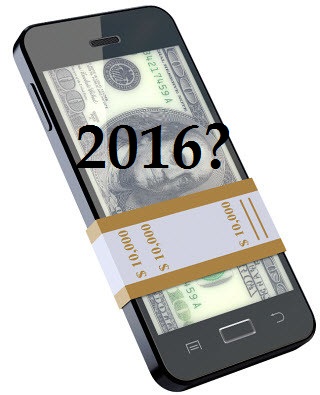Gartner has predicted that by 2018, about 50 percent of shoppers will use wearables or smartphones to pay for purchases.
Research firm, Gartner Inc., has released a recent prediction that wearable technology will play a tremendously larger role in mobile payments over the next few years, saying that half of all consumers will be using them or smartphones for that purpose by the close of 2018.
This forecast has come at a time in which mobile payments are still only just gaining initial adoption.
In markets such as Japan, North America and many countries throughout Western Europe, mobile payments remain a small but growing transaction technology. Gartner feels that by 2018, they will have become popular enough that fifty percent of consumers will be using their smartphones or wearable technology devices in order to complete transactions at checkout counters in retail stores and restaurants.
This also suggests that Gartner feels that wearable technology will also be growing in its popularity.
 According to Gartner principal research analyst, Amanda Sabia, “Innovation in apps, mobile devices and mobile services are impacting traditional business models, particularly in the way people use personal technology for productivity and pleasure.” Sabia also pointed out the importance that product managers come to understand who these shoppers actually are when it comes to catering to new devices and providing services, while discovering just how those gadgets are being used by those customers. “Knowing your customer is imperative in order to capture a fair share of spending opportunities in this dynamic marketplace.”
According to Gartner principal research analyst, Amanda Sabia, “Innovation in apps, mobile devices and mobile services are impacting traditional business models, particularly in the way people use personal technology for productivity and pleasure.” Sabia also pointed out the importance that product managers come to understand who these shoppers actually are when it comes to catering to new devices and providing services, while discovering just how those gadgets are being used by those customers. “Knowing your customer is imperative in order to capture a fair share of spending opportunities in this dynamic marketplace.”
There were three types of mobile payments that were described by Gartner within its recent report. It identified them as: wearables or smartphone based payments, branded mobile wallets from credit card issuers or banks, or branded mobile wallets from retailers.
Still, Gartner reported that those mobile payments services based on NFC technology – such as Android Pay, Apple Pay and Samsung Pay – will remain limited throughout the length of the forecast period simply because the partnerships between retailers and financial organizations for using smartphones and wearable technology in that way will not yet have been established. Moreover, consumers have yet to see the value in that type of payment transaction.
Industry experts in the retail sphere are predicting that the technology will start heating up next year.
With the close of 2015, there have been a number of predictions as to what will be taking off in 2016 and which trends will continue on their way, and many experts have been saying that they see mobile payments as something that will make an important splash before another year comes to a close.
The prediction is that mobile wallets will take off not only in retail stores but also other locations like restaurants.
Although there have been experts who have been predicting that mobile payments would be taking off for several years, the forecasts for 2016 are larger than ever before. With the introduction of chip credit cards, many people are saying that Samsung Pay, Android Pay and Apple Pay are going to be seen as more convenient and will start to become a normal form of transaction at retail counters and in restaurants. This will be an important shift as consumers have been quite resistant to stepping away from their plastic cards. According to CEB analyst, Andy Schmidt, 2016 could be the year in which that begins to change in a meaningful way.
The migration to chip cards could be just the opportunity that mobile payments need to make themselves known.
 Banks, credit card issuers and retailers have all been changing their plastic card technology to include chips and many technology experts believe this slowdown at the checkout counter will have consumers looking to other types of transaction to speed up the process. While chip cards are considered to be safer than the magnetic stripes, it takes several seconds longer for each transaction to be completed. With the combination of the change in habits and the slower process, it could be what consumers need to look to the various smartphone-based options to speed things up again.
Banks, credit card issuers and retailers have all been changing their plastic card technology to include chips and many technology experts believe this slowdown at the checkout counter will have consumers looking to other types of transaction to speed up the process. While chip cards are considered to be safer than the magnetic stripes, it takes several seconds longer for each transaction to be completed. With the combination of the change in habits and the slower process, it could be what consumers need to look to the various smartphone-based options to speed things up again.
For this reason, it is expected that many companies are all going to do their part to stand out in the mobile wallet marketplace. There are already a large number of options, including major players such as Samsung, Apple, Google and even a recent entry by Walmart. Target has also announced that it’s working on its own option, while keeping its position as an important member of the anticipated MCX mobile payments app, as well. The belief seems to be that retailers – individually and as parts of consortiums – will be offering and receiving smartphone based transactions in the largest numbers yet throughout 2016.
 According to Gartner principal research analyst, Amanda Sabia, “Innovation in apps, mobile devices and mobile services are impacting traditional business models, particularly in the way people use personal technology for productivity and pleasure.” Sabia also pointed out the importance that product managers come to understand who these shoppers actually are when it comes to catering to new devices and providing services, while discovering just how those gadgets are being used by those customers. “Knowing your customer is imperative in order to capture a fair share of spending opportunities in this dynamic marketplace.”
According to Gartner principal research analyst, Amanda Sabia, “Innovation in apps, mobile devices and mobile services are impacting traditional business models, particularly in the way people use personal technology for productivity and pleasure.” Sabia also pointed out the importance that product managers come to understand who these shoppers actually are when it comes to catering to new devices and providing services, while discovering just how those gadgets are being used by those customers. “Knowing your customer is imperative in order to capture a fair share of spending opportunities in this dynamic marketplace.”
 Banks, credit card issuers and retailers have all been changing their plastic card technology to include chips and many technology experts believe this slowdown at the checkout counter will have consumers looking to other types of transaction to speed up the process. While chip cards are considered to be safer than the magnetic stripes, it takes several seconds longer for each transaction to be completed. With the combination of the change in habits and the slower process, it could be what consumers need to look to the various smartphone-based options to speed things up again.
Banks, credit card issuers and retailers have all been changing their plastic card technology to include chips and many technology experts believe this slowdown at the checkout counter will have consumers looking to other types of transaction to speed up the process. While chip cards are considered to be safer than the magnetic stripes, it takes several seconds longer for each transaction to be completed. With the combination of the change in habits and the slower process, it could be what consumers need to look to the various smartphone-based options to speed things up again.